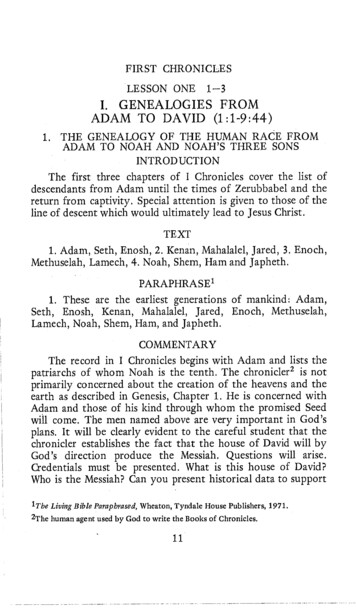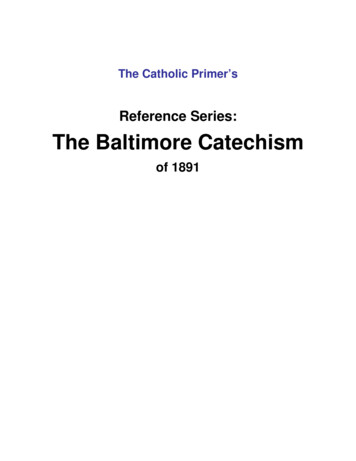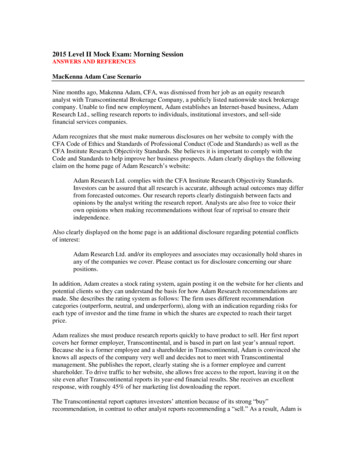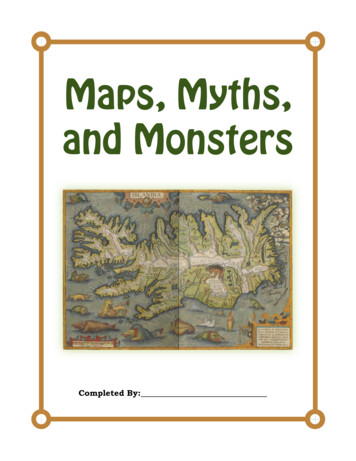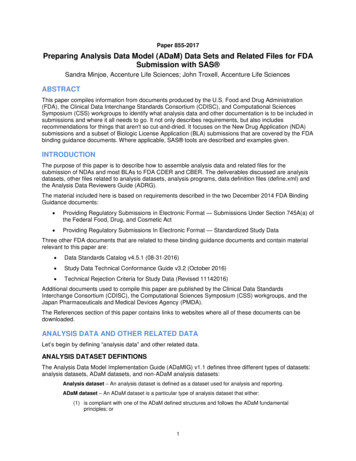
Transcription
Paper 855-2017Preparing Analysis Data Model (ADaM) Data Sets and Related Files for FDASubmission with SAS Sandra Minjoe, Accenture Life Sciences; John Troxell, Accenture Life SciencesABSTRACTThis paper compiles information from documents produced by the U.S. Food and Drug Administration(FDA), the Clinical Data Interchange Standards Consortium (CDISC), and Computational SciencesSymposium (CSS) workgroups to identify what analysis data and other documentation is to be included insubmissions and where it all needs to go. It not only describes requirements, but also includesrecommendations for things that aren't so cut-and-dried. It focuses on the New Drug Application (NDA)submissions and a subset of Biologic License Application (BLA) submissions that are covered by the FDAbinding guidance documents. Where applicable, SAS tools are described and examples given.INTRODUCTIONThe purpose of this paper is to describe how to assemble analysis data and related files for thesubmission of NDAs and most BLAs to FDA CDER and CBER. The deliverables discussed are analysisdatasets, other files related to analysis datasets, analysis programs, data definition files (define.xml) andthe Analysis Data Reviewers Guide (ADRG).The material included here is based on requirements described in the two December 2014 FDA BindingGuidance documents: Providing Regulatory Submissions in Electronic Format — Submissions Under Section 745A(a) ofthe Federal Food, Drug, and Cosmetic Act Providing Regulatory Submissions In Electronic Format — Standardized Study DataThree other FDA documents that are related to these binding guidance documents and contain materialrelevant to this paper are: Data Standards Catalog v4.5.1 (08-31-2016) Study Data Technical Conformance Guide v3.2 (October 2016) Technical Rejection Criteria for Study Data (Revised 11142016)Additional documents used to compile this paper are published by the Clinical Data StandardsInterchange Consortium (CDISC), the Computational Sciences Symposium (CSS) workgroups, and theJapan Pharmaceuticals and Medical Devices Agency (PMDA).The References section of this paper contains links to websites where all of these documents can bedownloaded.ANALYSIS DATA AND OTHER RELATED DATALet’s begin by defining “analysis data” and other related data.ANALYSIS DATASET DEFINTIONSThe Analysis Data Model Implementation Guide (ADaMIG) v1.1 defines three different types of datasets:analysis datasets, ADaM datasets, and non-ADaM analysis datasets:Analysis dataset – An analysis dataset is defined as a dataset used for analysis and reporting.ADaM dataset – An ADaM dataset is a particular type of analysis dataset that either:(1) is compliant with one of the ADaM defined structures and follows the ADaM fundamentalprinciples; or1
(2) follows the ADaM fundamental principles defined in the ADaM model document andadheres as closely as possible to the ADaMIG variable naming and other conventions.Non-ADaM analysis dataset – A non-ADaM analysis dataset is an analysis dataset that is not anADaM dataset. Examples of non-ADaM analysis datasets include: an analysis dataset created according to a legacy company standard an analysis dataset that does not follow the ADaM fundamental principles.This same document includes a figure showing the relationships of these types of datasets:Figure 1: copy of “ADaMIG v1.1 Figure 1.6.1 Categories of Analysis Datasets”Basically, an analysis dataset is either an ADaM dataset or a non-ADaM analysis dataset. There arethree standard structural classes of ADaM datasets: ADSL (Subject-Level Analysis Dataset) BDS (Basic Data Structure) OCCDS (Occurrence Data Structure) if using ADaMIG v1.1; or ADAE (Adverse Event AnalysisDataset) if using ADaMIG v1.0.Occasionally, there may be an analysis need which no standard structure can address. For example, nostandard structure enables generation of a correlation matrix of time-varying dependent variables. In thatcase, the unmet analysis need can be addressed by designing a dataset with a non-standard structure.Such a dataset is an ADaM dataset only if follows all of the ADaM fundamental principles and otherADaM conventions. These true ADaM datasets that cannot follow a standard ADaM structure areconsidered to be members of the ADaM Other class of ADaM datasets.A non-ADaM analysis dataset is any analysis dataset that is not compliant with ADaM. Non-ADaManalysis datasets are not broken down into structures or classes the way ADaM datasets are.2
STANDARDS ACCEPTED BY FDAThe FDA Data Standards Catalog v4.5.1 (08-31-2016) lists all supported and required standards. Foranalysis data, the only standards included are ADaM v2.1 and ADaMIG v1.0.The FDA Study Data Technical Conformance Guide (SDTCG) v3.2 states that they will also acceptstandards described in the following CDISC Therapeutic Area User Guides (TAUGs): Chronic Hepatitis C Dyslipidemia Diabetes QT Studies TuberculosisThese TAUG standards are developed quickly and are often finalized before ADaM documents can beupdated.WHY DOES FDA WANT ADAM?Standards are developed and used for many reasons, including to increase efficiency. The FDA SDTCGstates that ADaM facilitates their review, simplifies programming steps necessary for performing analysis,and promotes traceability from analysis results to ADaM datasets to SDTM datasets.Specifics not mentioned in the FDA documents are that reviewers have been receiving more and moreADaM data and are getting used to using it. They’ve also been provided training and tools to help themuse this data in their reviews.FORMAT OF DATASETS SUBMITTED TO THE FDAThe FDA SDTCG v3.2 states that the only way electronic datasets can be submitted to the FDA is in thefile format of SAS Transport Format v5. These transport files can be created using SAS PROC COPY orin a DATA step. Native SAS datasets such as those with extension “sas7bdat”, as well as transport filescreated using SAS PROC CPORT, are not accepted.Although SAS PROC COPY allows multiple SAS datasets to be combined into a single transport file, FDArequires that for submission each SAS dataset be converted into a SAS transport file. Moreover, thename of the transport file must have the same name as the dataset. For example, adae.sas7bdat must beconverted to adae.xpt.Information Beyond the FDA DocumentsThe reason for the requirement of this “old” version of the SAS transport file is that SAS v5 transport is anopen file format. In other words, data can be translated to and from SAS v5 transport and other commonlyused formations without the use of programs from SAS Institute (or any other specific vendor).Because the v5 file format is so old, it doesn’t understand many of the newer features of SAS. In fact, thisis the reason CDISC data standards such as SDTM and ADaM restrict dataset and variable names to 8characters, dataset and variable labels to 40 characters, and character variable lengths to 200 charactersor less. Longer versions of any of these items will be truncated and/or an error message will be generatedwhen the transport file is created.Also watch out for newer or user-specified SAS display formats. Any format that isn’t known to SAS v5transport will be lost when the transport file is created. For dates, this means displays of the date, such asvia the SAS Viewer or PROC PRINT, will show the number of days since Jan 1, 1960, the underlyingcontent of the date variable. For times and datetimes, this means that a number of seconds will appear.Only use formats that are standard in SAS V5.3
To ensure that no data or formatting is lost when creating the SAS transport file, consider using avalidation process such as:(1) Create a SAS dataset(2) Create a SAS v5 transport file from the SAS dataset using SAS PROC COPY or the DATA step.For example:libname adam"C:\desktop\data\adam";libname xptfile xport "C:\desktop\data\xport\adsl.xpt";data xptfile.adsl;set adam.adsl;run;(3) Convert the SAS v5 transport file into a new SAS dataset. For example:libname xptfile xport "C:\desktop\data\xport\adsl.xpt";libname new"C:\desktop\data\new\";data new.adsl;set xptfile.adsl;run;(4) Use SAS PROC COMPARE to compare the new dataset with the original version to check fordiscrepancies. For example:libname adam "C:\desktop\data\adam";libname new "C:\desktop\data\new\";proc compare base adam.adsl compare new.adsl printall;title "Comparison of adam.adsl (BASE) and new.adsl (COMPARE)";run;SIZE REQUIREMENTS FROM THE FDAAnother requirement found in the FDA SDTCG v3.2 is that the allotted length for each variable containingtext be set to the maximum length needed by that variable. Artificially setting all text variables to a lengthof 200 makes the dataset much larger and more difficult for the reviewers to work with.FDA SDTCG v3.2 sets the maximum size of a submitted dataset to 5 gigabytes (GB). Many different toolscan be used to do a review, and not all of them can handle datasets larger than 5GB. Larger datasetsmust be split, and both versions (split and non-split) must be submitted. There is a separate directory tohold the split datasets.Information Beyond the FDA DocumentsThere are at least two reasons why programmers may not set character variable lengths appropriately: Setting the variable lengths appropriately requires some effort, involving consideration of CDISCand sponsor standards as well as examination of collected and derived data values. Programmers, especially those with an Oracle background, may not be aware of how SASallocates memory for character variables. In SAS, variable length 200 always uses 200 bytes ofstorage for that variable on every record, even if the actual data value on a record is only 1character or null. In contrast, Oracle’s VARCHAR200 data type allocates only as much storage asrequired by the actual data value on a given record.When trimming SAS variable lengths to the minimum necessary to contain the maximum actual datavalues, it is best to look across all datasets rather than in only one dataset at a time. This is because dataprocessing such as SET and MERGE statements can result in inadvertent truncation if lengths of4
variables with the same name vary across datasets. Also, in some cases, it may pay to anticipate futureuses such as data integration when setting variable lengths.The FDA split rule described above was put in place to handle the CDISC Study Data Tabulation Model(SDTM) data requirement that all data of the same type be put into a single dataset. For example, alllaboratory tests are required to be part of domain LB, even if that means the dataset will be larger than 5GB.In ADaM, there is no requirement that all data of the same type be put into a single dataset. Not only dosmaller datasets not require splitting at submission time, they are nimbler and can reduce program runtimes. When it makes sense, consider creating multiple smaller, focused datasets rather than fewer large,cumbersome ones.DATASET SUBMISSION LOCATIONThe FDA SDTCG v3.2 includes this figure to show where to put all data and related submission items:Figure Error! Use the Home tab to apply 0 to the text that you want to appear here.2: copy of “FDASDTCG v3.2 Figure 1: Folder Structure for Study Datasets”Additionally, ADaMIG v1.1 describes that for ease of use with the define file and in the eCTD folderstructure, all analysis datasets for a study should be kept in a single folder, either adam or legacy, usingthe following rules: If a set of analysis datasets includes an ADaM-compliant ADSL dataset (as required for a CDISCconformant submission), then the whole set of analysis datasets for that study belongs in theadam folder5
If not, the whole set of analysis datasets for that study belongs in the legacy folder.If the study includes an ADaM-compliantADSL, place the whole set of analysisdatasets in this subfolderOtherwise, place the study’s whole set ofanalysis datasets in this subfolderFigure Error! Use the Home tab to apply 0 to the text that you want to appear here.3: AnalysisDataset Submission FoldersInformation Beyond the FDA and CDISC DocumentsAlthough the FDA binding guidance documents say that ADaM is only required in NDA and BLAsubmissions for studies that start after December 17, 2016, ADaM can be submitted for other studies.Reviewers have tools and training to support the use of this standard, and it could theoretically speed upthe time it takes for them to do their review.FDA Data Standards Catalog (v4.5.1) does not yet include ADaMIG v1.1, only ADaM v2.1 and ADaMIGv1.0. As of this writing, FDA is evaluating ADaMIG v1.1 for use with their tools. In the interim, check withthe relevant FDA reviewing division if you want to submit datasets following ADaMIG v1.1, because theymay allow a waiver.WHICH DATASETS TO CREATE AND SUBMITThe CDISC ADaM standard requires ADSL. ADaMIG v1.1 states that it is up to the sponsor to determinewhat other analysis datasets are created.The FDA Technical Rejection Criteria for Study Data document states that ADSL is required in the NDAand BLA submission for all studies starting after December 17, 2016. The FDA SDTCG states thatsponsors should submit ADaM datasets to support key efficacy and safety analyses.Information Beyond the FDA DocumentsBased on the text in the FDA documents, a sponsor may choose not to submit any datasets other thanADSL and those used for key efficacy and safety analyses. This is risky, because a reviewer may ask foradditional datasets during review. The sponsor would then need to submit quickly these additionaldatasets, and potentially slow down the review time. A safer solution is to discuss with the review division,perhaps at a pre-NDA or pre-BLA meeting, which datasets to include in the submission.MISCELLANEOUS DATAFigure 2 includes a folder called misc. The FDA SDTCG v3.2 specifies that miscellaneous datasets,which don’t qualify as analysis, profile, or tabulation datasets, should be put in this folder.Although not specified in the SDTCG, miscellaneous datasets would include any data not captured inSDTM but used to create ADaM datasets. Look-up tables, such as a list of prohibited concomitantmedications, and deviations collected somewhere other than on the CRF are examples of thismiscellaneous data.6
ANALYSIS PROGRAMSRecall that all the analysis datasets for a study are placed in either the adam or legacy datasets folder.Within each of these folders, at the same level as the datasets folder, is a programs folder. The FDASDTCG states that the programs folder is where to put programs used to create analysis datasets,tables, and figures associated with primary and secondary efficacy.Place study programs in this subfolder ifthe study datasets are in theadam/datasets folder- OR Place study programs in this subfolder ifthe study datasets are in thelegacy/datasets folderFigure Error! Use the Home tab to apply 0 to the text that you want to appear here.4: AnalysisPrograms Submission FoldersThe FDA SDTCG document describes that the purpose of these programs is to understand the processand confirm analysis algorithms. This implies that that programs not expected to be run directly on theFDA system. The SDTCG requires that submitted programs to be ASCII text files (*.txt) or PDF files(*.pdf).Information Beyond the FDA DocumentsThe practical impact may be illustrated with an example. When a SAS program called adtte.sas isprepared for submission, it would become adtte.txt or adtte.pdf. Some reviewers may take snippets ofcode to replicate the sponsor’s analysis results and modify them to test alternate approaches.Although not specifically stated in the FDA SDTCG, consider submitting at least all programs used tocreate the submitted datasets and key analyses. If not submitting all programs, be prepared to providethem for any FDA Reviewer requests.To make submitted programs as easy as possible for FDA Reviewers to read and use, consider includingrobust comments and using non-macro language as much as possible. Also, it may not be necessary toinclude the table program code that put the results into specific places on the table. In other words, theprogram that was actually used to create the table may not be the program that is submitted.It is worth noting that the Japanese PMDA regulatory agency has similar text in their TechnicalConformance Guide. In addition, that PMDA document includes text about submission of full complexprograms including macros: “ if submission of the macro program is difficult or submission of the programitself is difficult because the creation of the dataset or program was outsourced, the submission ofspecifications that show the analysis algorithm would be sufficient.” Although the FDA SDTCG doesn’tcontain this text, it might be something to discuss with the relevant FDA reviewing division before blindlysubmitting complex and macro-driven programs.DATA DEFINITION FILES (DEFINE.XML)The data definition (define) file describes the metadata of submitted electronic datasets. The DSTCGstates that the data definition file is “arguably the most important part of the electronic dataset submissionfor regulatory review”. It also states that “An insufficiently documented data definition file is a commondeficiency that reviewers have noted.”7
DEFINE CONTENTCDISC has useful document packages on define.xml that can be downloaded for free. In addition torobust specifications, these document packages each include examples of how to lay out a define.xmlfile. The Analysis Results Metadata Specification v1.0 for Define-XML v2 (Jan 2015) contains examplesand instructions for creating all the metadata needed for an analysis dataset submission: Dataset-level Metadata Variable-level Metadata Parameter Value-level Metadata, when appropriateoNote that Value-Level Metadata is essential for describing ADaM Basic Data Structuredatasets containing metadata that vary according to analysis parameter Results-level Metadata (recommended for critical analyses) Controlled terminology and codes Links to other documents, such asoStatistical Analysis Plan (SAP)oAnalysis Data Reviewers Guide (ADRG)DEFINE VERSIONThe FDA Data Standards Catalog v4.5.1 lists define.xml v1.0 and define.xml v2.0. The define.pdf is notincluded in the Data Standards Catalog v4.5.1, but it was a former standard and might be allowed via awaiver.The DSTCG recommends using the standard define.xml v2.0. One reason for this recommendation is thatversion 2.0 allows printing of the define.xml file, something reviewers regularly need to do. Additionally,define.xml v1.0 only included dataset-level and variable-level metadata, because it was written before anyof the current ADaM documents and designed specifically for the submission of SDTM data. Thedefine.xml v2.0 added value-level metadata. The Analysis Results Metadata Specification v1.0 for DefineXML v2 (Jan 2015) added results-level metadata, and is the best option to accompany ADaM datasets.SET OF DEFINE FILESThe define.xml file is very difficult to read in its native form, since it contains both textual content and XMLcode and symbols. It needs a stylesheet to allow the XML code to render properly for humanconsumption. CDISC has provided in their packages an example stylesheet that works across manybrowsers. It is not required that this CDISC-provided stylesheet be used; however doing so can helpensure that a submission reviewer will see the define in the layout that the sponsor intended.A define.html and define.pdf may also be provided. The define.pdf can be useful for printing.8
Below is an example of some typical define files. Note that they are shown here along with the ADaMdatasets.Figure 5: Example of Define FilesDEFINE SUBMISSION LOCATIONBecause of technology constraints, links sometimes don’t work when referencing material in a differentfolder. This means that each folder with datasets must have its own define file. For analysis data, thismeans the define file is located in the appropriate datasets folder:Place define file in this subfolder ifthe study datasets are in this folder- OR Place define file in this subfolder ifthe study datasets are in this folderFigure Error! Use the Home tab to apply 0 to the text that you want to appear here.6: Folder forAnalysis Data Definition fileANALYSIS DATA REVIEWERS GUIDE (ADRG)The Analysis Data Reviewers Guide (ADRG) is one of the newer components in submissions of analysisdata.ADRG PURPOSEThe introduction of the CSS ADRG Completion Guideline describes that the purpose of the submittedADRG is to provide “FDA Reviewers with additional context for analysis datasets (AD) received as part ofa regulatory submission.” It goes on to state that the “ADRG purposefully duplicates limited informationfound in other submission documentation (e.g., the protocol, statistical analysis plan, clinical study report,define.xml) in order to provide FDA Reviewers with a single point of orientation to the analysis datasets.”It also notes that “submission of a reviewer guide does not obviate the requirement to submit a completeand informative define.xml document to accompany the analysis datasets.”The DSTCG states “The ADRG provides FDA reviewers with context for analysis datasets andterminology, received as part of a regulatory product submission, additional to what is presented withinthe data definition file (i.e., define.xml).” and also “It should be noted that the submission of an ADRG9
does not eliminate the requirement to submit a complete and informative define.xml file corresponding tothe analysis datasets.”The Analysis Data Reviewers Guide (ADRG) package was created by the Computational SciencesSymposium (CSS). A zip file with a template, guidelines for completion, and examples can bedownloaded from phusewiki.org, and the CDISC Analysis Results Metadata Specification v1.0 for DefineXML v2 also contains an example ADRG.ADRG CONTENTThe ADRG is set up with standard sections and leading questions to prompt on what to say.The section on Dataset Processing is a good place to explain any complex data flows. For example, thefigure below shows the dependencies for a suite of ADaM datasets. Here ADAE, ADLB, and ADTR areused to create ADTTE; then ADTTE and ADBASE are used to create ADEFF:ADSLADAEADLBADTRADVSADBASEADTTEADEFFFigure 7: Complex Data Flow Diagram ExampleThe section on Conformance is the place to describe any conformance checks that were run, andexplain any issues found.ADRG SUBMISSION LOCATIONThe DSTCG recommends that an ADRG be included as part of any analysis data submission. Like thedefine files, it is submitted in the same folder as the analysis datasets:Figure 8: Example of a Folder with an ADRG File10
SUMMARYFor ADaM data, the following figure summarizes what to submit where:Datasets(SAS v5transport)ARDGDefinefilesPrograms for at least: Each dataset submitted Key analysesOther data, such as: Look-up tables Deviations not collected via CRFFigure 9: Summary of Submission Folder Locations and ContentThe datasets folder holds not only ADaM data, but also the define files and the ADRG. Submit a SAS v5transport file for each ADaM dataset, not the actual SAS datasets themselves. Include at least ADSL anddatasets used for key analyses, as negotiated with the review division. Include at least define.xml anddefine.xsl.The programs folder holds all submitted programs. Each program should be a text file (extension .txt) ora pdf (extension .pdf). Don’t submit programs with extension .sas.The misc folder holds data used to create ADaM that is not in the SDTM folders.Take advantage of the reference documents from FDA, CDISC, CSS, and PMDA for additional details.REFERENCESUnited States Food and Drug Administration. 2017. “Study Data Standards Resources.” AccessedJanuary 30, 2017. DataStandards/default.htm. This site contains all the FDA documents referenced in this paper. It is also where you’ll findemail addresses to ask questions to CDER/CBER.Clinical Data Interchange Standards Consortium. 2017. “Analysis Data Model (ADaM).” AccessedJanuary 30, 2017. https://www.cdisc.org/standards/foundational/adam. This site contains all the CDISC ADaM documents, including the Analysis Results Metadata.11
Clinical Data Implementation Standards Consortium. 2017. “Define-XML” Accessed January 30, define-xml. This site contains all the CDISC define.xml documents.PhUSE wiki. 2017. “Optimizing the Use of Data Standards.” Accessed January 30, 2017.http://www.phusewiki.org/wiki/index.php?title Optimizing the Use of Data Standards. This site contains the ADRG package.Japan Pharmaceuticals and Medical Devices Agency. 2017. “Notification No. 0427001”. AccessedFebruary 25, 2017. https://www.pmda.go.jp/files/000206449.pdf. This site contains the English translation of the PMDA Technical Conformance Guide.CONTACT INFORMATIONYour comments and questions are valued and encouraged. Contact the authors at:Sandra MinjoeAccenture Life Sciencessandra.minjoe@Accenture.comJohn TroxellAccenture Life Sciencesjohn.troxell@Accenture.comSAS and all other SAS Institute Inc. product or service names are registered trademarks or trademarks ofSAS Institute Inc. in the USA and other countries. indicates USA registration.Oracle is a registered trademark of Oracle Corporation and/or its affiliates.Other brand and product names are trademarks of their respective companies.12
ADaM conventions. These true ADaM datasets that cannot follow a standard ADaM structure are considered to be members of the ADaM Other class of ADaM datasets. A non-ADaM analysis dataset is any analysis dataset that is not compliant with ADaM. Non-ADaM analysis datasets are not broken down into structures or classes the way ADaM datasets are.

